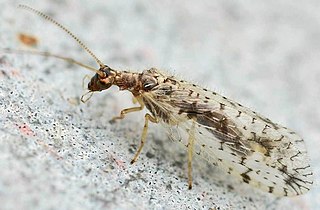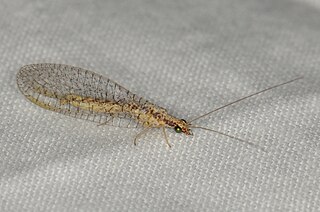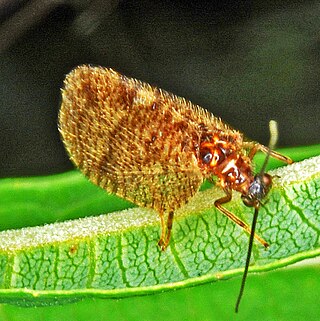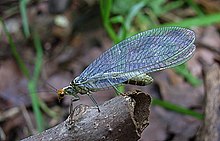
The insect order Neuroptera, or net-winged insects, includes the lacewings, mantidflies, antlions, and their relatives. The order consists of some 6,000 species. Neuroptera is grouped together with the Megaloptera and Raphidioptera (snakeflies) in the unranked taxon Neuropterida.

Green lacewings are insects in the large family Chrysopidae of the order Neuroptera. There are about 85 genera and 1,300–2,000 species in this widespread group. Members of the genera Chrysopa and Chrysoperla are very common in North America and Europe; they are very similar and many of their species have been moved from one genus to the other time and again, and in the nonscientific literature assignment to Chrysopa and Chrysoperla can rarely be relied upon. Since they are the most familiar neuropterans to many people, they are often simply called "lacewings". Since most of the diversity of Neuroptera are properly referred to as some sort of "lacewing", common lacewings is preferable.

Hemerobiidae is a family of Neuropteran insects commonly known as brown lacewings, comprising about 500 species in 28 genera. Most are yellow to dark brown, but some species are green. They are small; most have forewings 4–10 mm long. These insects differ from the somewhat similar Chrysopidae not only by the usual coloring but also by the wing venation: hemerobiids differ from chrysopids in having numerous long veins and forked costal cross veins. Some genera are widespread, but most are restricted to a single biogeographical realm. Some species have reduced wings to the degree that they are flightless. Imagines (adults) of subfamily Drepanepteryginae mimic dead leaves. Hemerobiid larvae are usually less hairy than chrysopid larvae.

Chrysoperla is a genus of common green lacewings in the neuropteran family Chrysopidae. Therein they belong to the Chrysopini, the largest tribe of subfamily Chrysopinae. Their larvae are predatory and feed on aphids, and members of this genus have been used in biological pest control.

Chrysopinae is the nominate subfamily of green lacewings in the insect family Chrysopidae in the order Neuroptera. This subfamily is also the largest within the family and comprises about 60 genera.

Chrysoperla carnea, one of the species of common green lacewing, is an insect in the Chrysopidae family. Although the adults feed on nectar, pollen and aphid honeydew, the larvae are active predators and feed on aphids and other small insects. It has been used in the biological control of insect pests on crops.

Semachrysa is a genus of green lacewing found from Japan to Australia along the Western part of the Pacific Ocean. 20 Semachrysa species have been described between 1914 and 2012. 15 of them - one of which was new - have been included in a recent taxonomic study:

Chrysopini is a tribe of green lacewings in the family Chrysopidae. There are about 32 genera and 926 described species in Chrysopini.

Eremochrysa is a genus of shadow lacewings in the family Chrysopidae. There are 18 described species in Eremochrysa.

Abachrysa is a genus of green lacewings in the family Chrysopidae. There is one described species in Abachrysa, Abachrysa eureka.

Nothochrysa californica, the San Francisco lacewing, is a species of green lacewing in the family Chrysopidae. It is found in North America.

Leucochrysa is a genus of green lacewings in the family Chrysopidae. As of 2013, there are 196 described species in Leucochrysa, found in the Americas.

Leucochrysini is a tribe of green lacewings in the family Chrysopidae. There are 7 genera and 213 described species in Leucochrysini.

Megalomus is a genus of brown lacewings in the family Hemerobiidae. There are more than 40 described species in Megalomus.

Psectra is a genus of brown lacewings in the family Hemerobiidae. There are more than 20 described species in Psectra.
Yumachrysa is a genus of green lacewings in the family Chrysopidae. There are at least four described species in Yumachrysa.

Chrysoperla rufilabris, also known as the red-lipped green lacewing, is a species of green lacewing in the family Chrysopidae.

Leucochrysa insularis is a species of green lacewing in the family Chrysopidae. It is found in the Caribbean Sea, Central America, and North America.

Mallada basalis is a species of green lacewing in the family Chrysopidae, first described by Francis Walker in 1853. No subspecies are listed in the Catalog of Life. The species was detected on mainland New Zealand in the 2010s.

Chrysoperla plorabunda, also known as the weeping green lacewing, is an insect belonging to the cryptic carnea complex of the genus. Species in the complex are nearly identical in morphology, with differences in substrate-borne vibrational songs being the only identifying factor. C. plorabunda has a widespread distribution across North America, ranging from coast to coast and from northern Canada down to Mexico. Within that range, they are typically found in open habitats such as grasslands and cultivated fields, as well as on the edges of deciduous forests and within coniferous forests. Adults feed predominately on nectar and honeydew, while larvae feed on other soft-bodied arthropods.



















